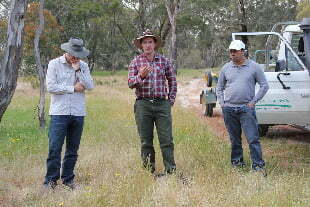The excellent newsletter Decision Point recently shared this interesting article by researchers Sayed Iftekhar and Dave Pannell on biases in NRM decision making. This is a must read for all of us involved in NRM.
People in all walks of life – from town planners to judges and financial regulators – are subject to bias in their perceptions and judgements. Of course, this applies to environmental managers and natural resource managers too. We recently explored the influence of bias in natural resource management (NRM) and found that we may be able to improve our performance if we recognise these influences and work to reduce them.

Sayed Iftekhar, on the right, listens to ecologist Geoff Kay in a grassy woodland (a threatened ecosystem). Sayed has investigated how NRM managers are often influenced by unacknowledged biases in their decision making.
Many shades of bias
Decision makers do not always perceive things accurately. It has been shown that, in making judgments dealing with uncertainty, decision makers are susceptible to different types of biases – beliefs that are inconsistent with reality or behaviors that compromise the achievement of objectives.
There is some research around which demonstrates that people are subject to a range of biases. However, the influence of bias has received little attention in the conservation literature. We set out to explore the consequences of these biases on NRM in general and adaptive management in particular (Iftekhar and Pannell, 2015).
Based on our survey of the economics and psychology literature we explored the impacts of action bias, the planning fallacy, reliance on limited information, limited reliance on systematic learning, framing effects, and reference-point bias.
Dealing with the planning fallacy
Each bias can have an adverse impact on our capacity to undertake effective adaptive natural resource management. The ‘planning fallacy’, as one example, is the tendency of project planners to be excessively optimistic about the performance of a project that they are developing. It’s a very common bias and we suspect that it has led to some very poor decisions being made about major NRM investments.
A strategy to reduce the planning fallacy is to ask managers to forecast the completion time, cost, or benefits for a range of comparable projects rather than a single project. This strategy, known as Reference Class Forecasting, has been effective in reducing time and cost overruns of large infrastructure projects.
Where the planning fallacy is in evidence, adaptive management may help to reduce its adverse consequences. Adaptive management, involving information collection and refinement of project design, helps in correcting decisions that were initially made on an excessively confident or optimistic basis. If necessary, targets can be modified or the project can be terminated following the collection of improved information.
A strategy to reduce the planning fallacy is to ask managers to forecast the completion time, cost, or benefits for a range of comparable projects rather than a single project.
The consequences of bias
Based on our survey of the economics and psychology literature, we believe that environmental managers and natural resource managers should be on the look out for a range of common biases that have the potential to adversely impact NRM and specifically adaptive management (see the box ‘Nine shades of bias’).
Based on what we know about these biases there is evidence to expect that:
- Managers are likely to undertake on-ground actions even when these are not worthwhile.
- They could suffer from the cognitive illusion of being more in control of the system than they actually are.
- They could be overconfident about the expected outcome of their decisions.
- They may be overly optimistic in terms of expected completion time of the project.
- They might rely on a partial set of information for decision making even when more complete information is available.
- They might rely on trial-and-error learning and repeating their past successful choices instead of collecting and comparing information about the full set of decision options; and
- Managers could try to achieve predefined goals rather than the best possible outcomes from a project.
Minimising the impact
Bias is a part of human life. The take home message from this study is that NRM agencies need to be aware of the influence of biases when management decisions are undertaken. There are many things they can do that will help minimise the impact of bias.
First, agencies need to promote a culture of learning. It needs to be recognized that both successful and failed projects generate valuable information about the future state and expected impacts of the management interventions. This could be done by providing appropriate incentives (tangible and intangible) for the managers and decision makers to consider the full range of options before making any decision, or asking managers to justify their decisions to external parties.
Second, adoption of a decision support system could facilitate retention and storing of relevant information. It may also make learning from past projects easier and help in systematic evidence-based decision making. Of course, relevant staff should be adequately trained and properly incentivized to use such systems.
Third, conducting benefit-cost analyses of planned options would help to refine and prioritize the options during the design phase of an adaptive management cycle. Benefit-cost analysis provides a systematic and objective framework to include all relevant costs and benefits (both market and nonmarket goods and services) related to a project. In the process of identifying benefits and costs, it also helps in identifying whether there is complementarity among them (to avoid double counting) and the time lag and uncertainty attached to realization of each benefit and each cost. Thus, benefit-cost analysis could be used as a tool to comprehensively assess the expected merits of a project.
Fourth, involvement of external third-party reviewers may also help in designing more realistic and feasible projects.
And, finally, scenario analysis should be conducted as part of the assessment and design phase to anticipate the expected outcomes of different options. It is advisable to consider the likely impacts of different types of biases, and the effectiveness of potential remedial measures before making any final recommendation for use in decision making for natural resources.
Nine shades of bias
Here are nine behavioral biases that we believe can potentially affect adaptive management
Action bias: Tendency to take actions even when it is better to delay action
Framing effect: Tendency to respond differently to alternatively worded but objectively equivalent descriptions of the same item
Reference-point bias: Tendency to overemphasize a predetermined benchmark for a variable when estimating the level of that variable
Availability heuristic: Tendency to give more weight to events that can be recalled more easily
Planning fallacy: Making judgments about a planned activity that are systematically over-optimistic, including underestimating project completion time, underestimating costs, or overestimating benefits
“Satisficing rule”: Tendency to stop searching for a better decision once a decision that seems sufficiently good is identified
Loss aversion: Tendency to value losses more highly than similar gains
Reliance on limited information: Tendency to use a subset of information even when full set of information is available
Limited reliance on systematic learning: Tendency to use information from past successful efforts rather than using information from both successful and failed efforts.
Studying behavioral bias
Both psychology and economics have rich literatures on the influences of different types of bias on behavior. Experimental economics serves three main purposes: testing theories, building new theories from observing experimental outcomes, and testing policy and management options. Behavioral economics also integrates insights from psychology to explain economic decision making. It studies the effects of psychological factors such as emotional, social, and cognitive factors on many decisions and economic processes. A related field is behavioral decision theory, which studies how people make decisions as well as how they should make decisions.
More info: Sayed Iftekhar mdsayed.iftekhar@uwa.edu.au
Reference
Iftekhar MS & DJ Pannell (2015). “Biases” in Adaptive Natural Resource Management. Conservation Letters. doi:10.1111/ conl.12189 http://onlinelibrary.wiley.com/enhanced/doi/10.1111/conl.12189/
Article reproduced from Decision Point Online Issue #93 November-December 2015

